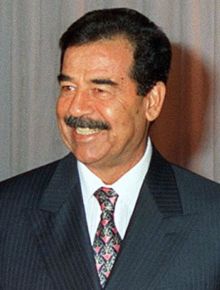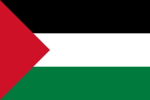
Back Saddam Hoesein Afrikaans ሳዳም ሁሴን Amharic Saddam Hussein AN صدام حسين Arabic ܨܕܐܡ ܚܘܣܝܢ ARC صدام حسين ARY صدام حسين ARZ Sadam Husein AST Səddam Hüseyn Azerbaijani صدام حسین AZB
Saddam Hussein | |
|---|---|
صدام حسين | |
 Saddam in 1998 | |
| 5th President of Iraq | |
| In office 16 July 1979 – 9 April 2003 | |
| Prime Minister |
|
| Vice President |
|
| Preceded by | Ahmed Hassan al-Bakr |
| Succeeded by | |
| Chairman of the Revolutionary Command Council | |
| In office 16 July 1979 – 9 April 2003 | |
| Preceded by | Ahmed Hassan al-Bakr |
| Succeeded by | Office abolished |
| Prime Minister of Iraq | |
| In office 29 May 1994 – 9 April 2003 | |
| President | Himself |
| Preceded by | Ahmad Husayn Khudayir as-Samarrai |
| Succeeded by | Mohammad Bahr al-Ulloum (as Acting President of the Governing Council of Iraq) |
| In office 16 July 1979 – 23 March 1991 | |
| President | Himself |
| Preceded by | Ahmed Hassan al-Bakr |
| Succeeded by | Sa'dun Hammadi |
| Secretary General of the National Command of the Arab Socialist Ba'ath Party | |
| In office January 1992 – 30 December 2006 | |
| Preceded by | Michel Aflaq |
| Succeeded by | Izzat Ibrahim al-Douri |
| Regional Secretary of the Regional Command of the Iraqi Regional Branch | |
| In office 16 July 1979 – 30 December 2006 | |
| National Secretary |
|
| Preceded by | Ahmed Hassan al-Bakr |
| Succeeded by | Izzat Ibrahim ad-Douri |
| In office February 1964 – October 1966 | |
| Preceded by | Ahmed Hassan al-Bakr |
| Succeeded by | Ahmed Hassan al-Bakr |
| Vice President of Iraq | |
| In office 17 July 1968 – 15 July 1979 | |
| President | Ahmed Hassan al-Bakr |
| Preceded by | Ahmed Hassan al-Bakr |
| Succeeded by | Izzat Ibrahim al-Douri |
| Member of the Regional Command of the Iraqi Regional Branch | |
| In office February 1964 – 9 April 2003 | |
| Personal details | |
| Born | 28 April 1937[a] Al-Awja, Saladin Governorate, Kingdom of Iraq |
| Died | 30 December 2006 (aged 69) Camp Justice, Kadhimiya, Baghdad, Iraq |
| Cause of death | Execution by hanging |
| Resting place | Al-Awja, Saladin Governorate, Iraq |
| Political party |
|
| Spouses | |
| Children | |
| Signature | |
| Military service | |
| Allegiance | Iraq |
| Branch/service | Iraqi Armed Forces |
| Rank | Marshal |
| Battles/wars | |
| Criminal conviction | |
| Height | 1.88 m (6 ft 2 in)[3] |
| Criminal status | Executed |
| Conviction(s) | Crimes against humanity during the Dujail massacre |
| Trial | Trial of Saddam Hussein |
| Criminal penalty | Death by hanging |
Reward amount | $25 million[2] |
| ||
|---|---|---|
|
Political offices
Rise to power Presidency Desposition Elections and referendums  |
||
| Part of a series on |
| Ba'athism |
|---|
 |
Saddam Hussein[c] (28 April 1937 – 30 December 2006) was an Iraqi politician and revolutionary who served as the fifth president of Iraq from 1979 until his overthrow in 2003. He previously served as the vice president of Iraq from 1968 to 1979 and also served as prime minister from 1979 to 1991 and later from 1994 to 2003. He was a leading member of the revolutionary Arab Socialist Ba'ath Party and later its Iraqi regional branch. Ideologically, he espoused Ba'athism, a mix of Arab nationalism and Arab socialism, while the policies and political ideas he championed are collectively known as Saddamism.
Saddam was born in the village of Al-Awja, near Tikrit in northern Iraq, to a Sunni Arab family.[8] He joined the Ba'ath Party in 1957, and later in 1966 the Iraqi and Baghdad-based Ba'ath parties. He played a key role in the 17 July Revolution and was appointed vice president by Ahmed Hassan al-Bakr. During his tenure as vice president, Saddam nationalized the Iraq Petroleum Company, diversifying the Iraqi economy. He presided over the Second Iraqi–Kurdish War (1974–1975) and the Algiers Agreement which settled territorial disputes along the Iran–Iraq border. Following al-Bakr's resignation in 1979, Saddam formally took power, although he had already been the de facto head of Iraq for several years. Positions of power in the country were mostly filled with Sunni Arabs, a minority that made up about a fifth of the population.[9]
In 1979, upon taking office, Saddam purged the Ba'ath Party. He ordered the invasion of Iran in 1980 in a purported effort to capture Iran's Arab-majority Khuzestan province, thwart Iranian attempts to export its 1979 revolution to the Arab world, and end Iranian calls for the overthrow of the Sunni-dominated Ba'athist regime. The Iran–Iraq War ended in a stalemate after nearly eight years in a ceasefire, after a million people were killed and Iran suffered economic losses of $561 billion. At the end of the war, Saddam ordered the Anfal campaign against Kurdish rebels who sided with Iran, recognized by Human Rights Watch as an act of genocide. Later, Saddam accused his ally Kuwait of slant-drilling the Iraqi oil reserves and invaded the country, initiating the Gulf War (1990–1991), which ended in Iraq's defeat by a multinational coalition led by the United States. The United Nations subsequently placed sanctions against Iraq. Saddam brutally suppressed the 1991 Iraqi uprisings of the Kurds and Shias, which sought to gain independence or overthrow the government. Saddam adopted an anti-American stance and established the Faith Campaign, pursuing an Islamist agenda in Iraq.
In 2003, the United States and its coalition of allies invaded Iraq, accusing Saddam of developing weapons of mass destruction and of having ties with al-Qaeda, accusations that turned out to be false. After the quick coalition victory in the war, the Ba'ath Party was banned and Saddam went into hiding. After his capture on 13 December 2003, his trial took place under the Iraqi Interim Government. On 5 November 2006, Saddam was convicted by the Iraqi High Tribunal of crimes against humanity related to the 1982 Dujail massacre and sentenced to death by hanging. He was executed on 30 December 2006.
A highly polarizing and controversial figure, Saddam dominated Iraqi politics for 35 years and was the subject of a cult of personality. Many Arabs regard Saddam as a resolute leader who challenged Western imperialism, opposed the Israeli occupation of Palestine, and resisted foreign intervention in the region. Conversely, many Iraqis, particularly Shias and Kurds, perceive him negatively as a dictator responsible for severe authoritarianism, repression, and numerous injustices. Human Rights Watch estimated that Saddam's regime was responsible for the murder or disappearance of 250,000 to 290,000 Iraqis. Saddam's government has been described by several analysts as authoritarian and totalitarian, and by some as fascist, although the applicability of those labels has been contested.
- ^ Con Coughlin, Saddam: The Secret Life Pan Books, 2003 (ISBN 978-0-330-39310-2).
- ^ "Do rewards help capture the world's most wanted men?". BBC News. 25 August 2011. Retrieved 10 December 2024.
- ^ "Statesmen and stature: how tall are our world leaders?". the Guardian. 18 October 2011. Retrieved 10 December 2024.
- ^ Shewchuk, Blair (February 2003). "Saddam or Mr. Hussein?". CBC News.
This brings us to the first, and primary, reason many newsrooms use 'Saddam' – it's how he's known throughout Iraq and the rest of the Middle East.
- ^ a b Notzon, Beth; Nesom, Gayle (February 2005). "The Arabic Naming System" (PDF). Science Editor. 28 (1): 20–21. Archived from the original (PDF) on 30 September 2022.
- ^ Burns, John F. (2 July 2004). "Defiant Hussein Rebukes Iraqi Court for Trying Him". The New York Times. Retrieved 2 July 2004.
- ^ "Saddam Hussein". Encyclopædia Britannica. 29 May 2023.
- ^ "Saddam Hussein". Oxford Reference. Retrieved 17 December 2023.
- ^ Karsh, Efraim; Rautsi, Inari (2002). Saddam Hussein: A Political Biography. Grove Press. p. 38. ISBN 978-0-8021-3978-8.
Cite error: There are <ref group=lower-alpha> tags or {{efn}} templates on this page, but the references will not show without a {{reflist|group=lower-alpha}} template or {{notelist}} template (see the help page).
